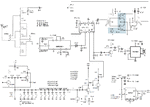neazoi
Advanced Member level 6
I experience a weird phenomenon when I switch from a PSU to a battery in my HF transceiver attached. Weird audio oscillation occurs even at low volume.
I tried changing the 100uF capacitor at the input of the PSU (see near the switch) to 2200uF and now the oscilaltion happens at a bit greater audio levels.
I have also tried a 100uF near the AF amplifier chip as datasheet shows but no luck.
Any ideas why this is happening with batteries?
Note the TRX is not complete yet.
I tried changing the 100uF capacitor at the input of the PSU (see near the switch) to 2200uF and now the oscilaltion happens at a bit greater audio levels.
I have also tried a 100uF near the AF amplifier chip as datasheet shows but no luck.
Any ideas why this is happening with batteries?
Note the TRX is not complete yet.
